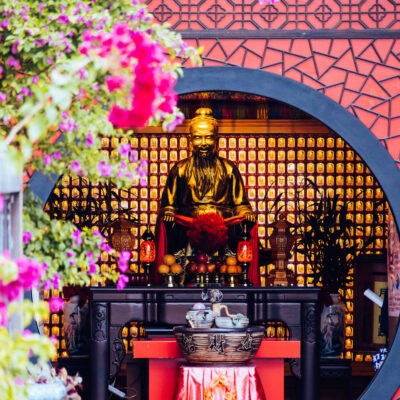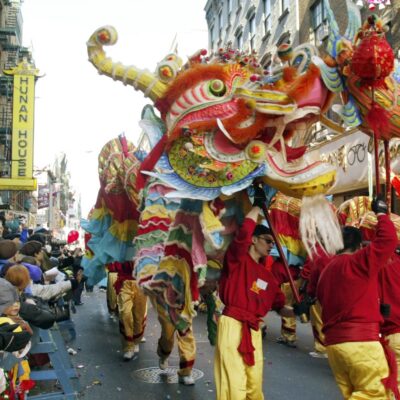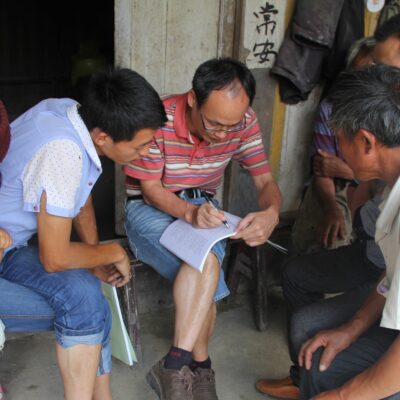中文 (Chinese translation)
Taiwan has been known for its rich natural resources ever since colonisers set their eyes on what they named ‘Isla Formosa’—the islands of beauty. The islands now known as Taiwan have endured a long and troubled colonial history, which shares some similarities with Indigenous experience in other nations such as Australia.
This year marks the 400th anniversary of the beginning of the appropriation of the Indigenous lands of Taiwan by external powers. However, despite centuries of successive invasions by increasingly powerful imperial entities, recent developments show hope for land rights agreements in consultation with Indigenous peoples and taking into account Indigenous knowledge.
In this article, I explore the colonial history of Taiwan and gradually shift to a focus on land tenure and land rights. I aim to demonstrate the resilience of Indigenous peoples despite the persistent efforts of colonisers to appropriate Indigenous lands.
Initial encounters
Taiwan’s Indigenous peoples first made contact with colonisers when Spain and Holland ventured to the island to take advantage of its strategic location in sea lanes. Spain built ports in the northern coastal area of Formosa in 1626, while the Dutch East India Company occupied the southern part of Formosa in 1624. The initial colonisers were not interested in bringing their own settlers to the islands; instead, they brought Han settlers from mainland China and formed what historian Tonio Andrade refers to as ‘cooperative colonisation’. The Dutch colonisers and the Chinese Empire cooperated in the partial occupation of Formosa. The Dutch colonisers offered tax breaks and allegedly ‘free’ land to Han colonists, using their powerful military to protect colonists from ‘aboriginal assault’. Shortly after the Dutch occupation of Taiwan in the 1620s, the number of Han settlers abruptly increased in the 1630s, corresponding with the labor immigration policy implemented by the Dutch colonisers, much the same as Australian colonial rulers brought Chinese labourers to parts of Australia in the nineteenth century.
However, Dutch efforts to secure a maritime port in Taiwan became pointless when the Japanese government implemented its isolationist foreign policy in the 1630s. The Dutch East India Company then turned its focus to governing its Taiwanese colony. Historical geographer Peide Kang describes the Dutch doctrine of ruling Taiwan’s Indigenous population in two ways: aggressive islet depopulation (an example of which is the Lamey Island Massacre in 1636) and plains resettlement (which Peide Kang concludes could not be deemed successful as only a few Indigenous communities complied with it).
A Ming loyalist, Cheng Cheng-kung (known as Koxinga in Dutch and English documents) expelled the Dutch East India Company in 1662. He had a family marine business in southern coastal China and fled to Formosa after the Manchu overthrew the Ming Dynasty and established the Qing Empire in 1644. In doing so, he established the Kingdom of Tungning on the base of the Dutch colonisation. The Cheng regime had similar policies in relation to Indigenous peoples as the Dutch colonisers. The main difference, as historian Baocun Dai points out, was that instead of importing Christianity, the Cheng regime imported Confucianism. Indigenous children were especially encouraged to attend the Confucian colleges, with admission starting at the age of eight. Indigenous parents were exempted from military service if their children attended these colleges.
The ‘savage border’
With Cheng Cheng-kung’s son and heir Cheng Ching’s death in 1681 and following family feuds, Cheng’s regime was rapidly shattered by the Qing Empire in continental China. The Qing Empire sent Admiral Shih Lang to launch a campaign against the Cheng regime which eventually surrendered in 1681. In 1684, the Qing Emperor ‘annexed’ Taiwan as part of its self-recognised territory. In reality, however, the regime was fragmented and never uncontested, as Taiwan studies scholar Jeffrey Bruce Jacobs noted.
The Qing occupation of Taiwan was a milestone, shifting from exploitation colonialism to settler colonialism. Han settlers were motivated to establish a new life in the colony and were eager to make Indigenous land their own. Previous colonisation was mainly concentrated in southern Taiwan, the lands of the Siraya people and now the location of Tainan City. The Qing regime initiated a more aggressive policy toward the Indigenous population in the western belt of the island. The Qing Court roughly categorised Indigenous peoples into ‘raw aborigines (生番; shêng fan)’, ‘civilised raw aborigines (化番; hua fan)’ and ‘cooked aborigines (熟番; shou fan)’. Using these offensive degrees of maturity to represent degrees of civilisation, or to be frank, Sinicisation, showed insulting evolutionist thinking. Hence, ‘raw aborigines’ were considered the most uncivilised and the least subjected to Qing rule. On the contrary, ‘cooked aborigines’ were subjected to the Qing court, such as paying tax and serving as assigned labourers at state direction. The Qing court understood the distinction between ‘raw’ and ‘cooked’ aborigines as a fluid and shifting boundary. The Indigenous groups that were ‘raw’ in one historical period might become ‘cooked’ at a later date through acculturating Han customs, which was desirable for the Qing court. Thus, there was the third category: the ‘civilised raw aborigines’ to describe this ambiguity and fluidity.
Anthropologist John Robert Shepherd’s work remarkably analysed how the Qing court made a well-articulated decision to allow the ‘cooked aborigines’ to take on roles assisting the government in ruling its new colony. After the Ta-Chia-Hsi Revolt of 1731-32, in which the Taokas people unsuccessfully fought back against the Qing colonisers, a power shift occurred in the western plains. Han official Taching Chang (張達京) arranged ‘cession of land for water’ agreements (割地換水; kêti huanshui) between Han tenants and Indigenous landlords. The paddy agriculture imported by Han settlers required irrigation systems, which were expensive and complex projects usually undertaken as joint investments. The ‘cession of land for water’ agreements guaranteed that Indigenous landlords would cede their lands to Han settlers in exchange for irrigation rights. These agreements often resulted in the ‘cooked aborigines’ losing their land tenure to the newly arrived Han settlers.
By the middle period of the Qing regime, the western plains had largely been ‘settled’ and many of the Indigenous groups living there were officially regarded as Qing subjects. But the Qing court’s regime did not reach highlands Taiwan and it was clear to foreign parties that only the western plains in Taiwan were under Qing jurisdiction, while the rest of the island remained autonomous and governed by Indigenous peoples. For instance, in 1869, American diplomat Charles Le Gendre signed a treaty with Paiwan chief Toh-ki-tok to guarantee the safety of his crew members after the Qing court stated that the Indigenous population there were not under its jurisdiction.
The Japanese Meiji punitive expedition to Taiwan in 1874, also known as the Mudan Incident, gave the Qing court a sharp warning. Before this event, the Qing court took a passive approach to controlling Taiwan. Prior to 1874, the Qing authority imposed quarantine policies and restrictions on immigration. Attempts were made to quarantine aboriginal territories by drawing what was labelled a ‘savage boundary (蕃界)’ and to limit the spread of Han settlement in Formosa to areas under effective government control. However, triggered by the Meiji punitive expedition, the Qing court initiated a more aggressive campaign of ‘opening the mountains and pacifying the savages (開山撫番)’ in the 1870s to proclaim their rule all over Formosa. What happened on the ground was far from their expectations, as British diplomat Herbert Allen Giles recorded: ‘Schemes for cutting roads through the hills were set on foot, colonists were bribed to settle in out-of-the-way places, and presents given liberally to the aboriginal chiefs, who were urged to acknowledge Chinese rule.’
The ‘savage land’
In 1895, under the terms of the Treaty of Shimonoseki, China’s Qing Dynasty ostensibly ceded Taiwan to Japan (however, as stated above, Qing occupation of the island of Taiwan in 1895 was neither complete nor uncontested). Historian Wen-Liang Lee argues that the Japanese occupation of Taiwan differed from previous regimes in that the state proclaimed Indigenous land as terra nullius (land belonging to no-one), unlike the Qing regime, which acknowledged Indigenous people’s land titles and even attempted to protect them for the Qing court‘s own benefit. Japan used this to justify the colonial government’s assertion of government ownership over aboriginal territory (蕃地; banti) and nationalising land titles.
In October 1895 (a few months after the takeover), the colonial government issued an ordinance declaring that forest and unclaimed land belonged to the Government unless claimants could prove ‘ownership’ through producing ‘land documents or other certain evidence’, or as the Chinese language version put it, ‘evidence from previous owners and land deeds’. The Japanese state nationalised all the land titles of the mountain area, which had been home to Formosan Indigenous peoples for generations. In 1902, Rokusaburō Mochiji 持地六三郎, councilor in the Ministry of Civil Affairs of the Taiwan Governor-General, weighed in to the ideological debate regarding the so-called ‘savage problem’ and this became the foundation of the Japanese colonial government’s Indigenous policies. He defined the ‘aboriginal problem’ first and foremost as a land problem:
Let me state clearly that when I refer to the problem of aboriginal lands: from the point of view of the Empire, there is only aboriginal land but not an aboriginal people. The problem of aboriginal land must be dealt with from an economic perspective and its management is an indispensable part of fiscal policy.
The Japanese state conducted a series of military actions to march into Indigenous domains to push the ‘savage borders’ forward in 1903. These actions came to a climax in 1910, when a ‘Five-Year Military Pacification Project’ to conquer Indigenous areas began. The State extended topographic investigation into the mountainous area and the categorisation decision was released in 1928. The central belt of Formosa was divided into different categories—as a conservation area (要存置林野; you sonti rinya), non-conservation area (不要存置林野; huyou sonti rinya) and quasi-conservation area (準要存置林野; zyun you sonti rinya). The ‘conservation area’ was secured for flood prevention and no cultivation was allowed. The ‘non-conservation area’ was open for economic exploitation; Japanese capitalists were subsequently invited to invest in the forestry business with governmental assistance. The ’quasi-conservation area’ also named ‘aboriginal territory (蕃地; banti)’, which constituted only small and fragmentary parts of the whole mountainous area, was left for Indigenous people to live in. Moreover, Aboriginal territory (蕃地; banti) was not included in the jurisdiction of general administration, but subjected to ‘aboriginal administration’ (理蕃政策; Riban seisaku), which was run by the police force.
The ‘Indigenous reserved land’ and ‘traditional territory’
With the defeat of the Japanese Empire in World War II, the Kuomintang-led Republic of China (ROC) government occupied Taiwan on behalf of the Allies in 1945. Regarding indigenous land policy, the ROC government largely inherited the formal government’s policies. The ROC government transformed the quasi-conservation areas zoned during the Japanese colonial era into ‘Indigenous reserved land’. In my previous work, I detailed how the ROC government initiated the general registry of Indigenous reserved land. Initially, in 1966 the government allowed Indigenous individuals to register other land rights, such as surface rights, cultivation rights, and others for ten years continuously in order to claim land ownership from when the regulation was first implemented. In 1998, the time frame as shortened to five years and then waived altogether in 2018 .
Challenged by increasing protests demanding democratisation, martial law was lifted in 1987 and social movements grew rapidly. Indigenous peoples campaigned for ‘Returning Our Land’ (還我土地運動; haiwot’uti Yüntung) in the late 1980s and early 1990s. In 1994, the ROC government made a constitutional amendment replacing ‘mountain compatriots’ with ‘Indigenous peoples’ to deliver formal recognition to the Austronesian population as being Indigenous. In 1997, the government further amended the Constitution to formally recognize the collective rights of the Austronesian population, including the term ‘Indigenous peoples’ with collective rights implications in the Constitution. In 2000, the Democratic Progressive Party’s candidate, Shui-bian Chen, won the presidential election. During his campaign, he signed a ‘New Partnership Between the Indigenous Peoples and the Government of Taiwan’ with Indigenous representatives. He then re-acknowledged the legitimacy of the treaty in 2002 after assuming office. The acknowledgment of Indigenous people’s ‘traditional territory’ was included in the New Partnership treaty. However, the concept of ‘traditional territory’ was not clearly defined legally.
In order to fulfill the promise made in the New Partnership Treaty, President Chen launched a nationwide five-year traditional territory investigation plan in 2002 to have its boundaries identified. The Indigenous Peoples Basic Law came into effect in 2005, and it states: Indigenous land ‘refers to the traditional territories and reservation land of indigenous peoples.’ Da-wei Kuan, a geographer, has delineated Taiwan’s traditional territory mapping process into three distinct phases. Firstly, Indigenous individuals, particularly cultural workers, initiated their own inquiries into traditional territories without receiving governmental funding or support. The second phase spans from 2002 to 2011, characterised by the government assuming a leading role in mapping Indigenous peoples’ traditional lands. Since 2012 there has been growing reflection and critique of the government-led mapping program and a notable increase in Indigenous communities organising their own mapping initiatives as a response to the government-led efforts.
The challenges
In 2016, President Ing-wen Tsai delivered the National Apology on behalf of the ROC government, and soon afterwards, the Presidential Office Indigenous Historical Justice and Transitional Justice Committee was established, with a subcommittee on Land Claims. The Subcommittee on Land Claims is responsible for investigating indigenous land claims and compiling rrecommendations, which are not legally binding. The lack of legal authority also hinders the Subcommittee’s ability to request information from other relevant government agencies, such as the Forestry Bureau, Council of Agriculture, and the Veterans Affairs Council, among others. Furthermore, the Indigenous Peoples Basic Law clearly stipulates in Article 20 that the government recognises Indigenous peoples’ rights to land and natural resources and shall establish an Indigenous Peoples’ Land Investigation and Management Committee. However, despite 19 years having passed since its promulgation, no legislation regarding the Indigenous Peoples’ Land Investigation and Management Committee has been enacted.
To exacerbate matters, President Tsai’s government enacted the controversial Regulations for Mapping Indigenous Land or Community Area in 2017. These regulations expressly stipulate that lands, both general land and Indigenous reserved land held as privately owned freehold titles, cannot be included in Indigenous peoples’ traditional territory under this regulation. I discussed the implications of this regulation in my previous work. The outrage of Indigenous peoples and their supporters towards the government sparked a protest campaign, leading Indigenous activists to establish a protest camp in front of the Presidential Office, an ongoing protest with striking similarities to the Aboriginal Tent Embassy fighting for land rights in Australia’s capital Canberra. The enactment of the regulation is a tragic setback for Indigenous people’s land rights. Since privately owned land, including both general land and Indigenous reserved land, cannot be zoned as traditional territories legally, developers are increasingly targeting privately owned Indigenous reserved land for development because development on legally zoned traditional territories requires obtaining the effected Indigenous community’s consent.
Future directions
The continuous waves of colonialisation in Taiwan do not present a pleasant story and Indigenous peoples in Taiwan undoubtedly still face significant challenges in asserting their land rights, often undermined by the government. However Indigenous peoples in Tiawan have survived 400 years of colonialisation and continue to thrive while asserting their land rights. The Spatial Planning Act was enacted in 2016, acknowledging and protecting Indigenous people’s land rights and ecological knowledge. Expected to come into force in 2025, the Act will coincide with the announcement and implementation of the ‘functional zone map’ by municipal and county (city) governments. There are high hopes that this will mark the first time in Taiwanese history that Indigenous knowledge is incorporated into the national spatial planning agenda, which reflects Indigenous peoples’ ongoing efforts to assert their autonomy and land rights.
Want more on Taiwan? Click here!
This article is based on the author’s doctoral dissertation.
Image: The protest camp of Indigenous land activists Panay and Nabu, 228 Peace Memorial Park, Taipei, February June 23, 2022. Credit: Author.
This article was edited very slightly after publication.




